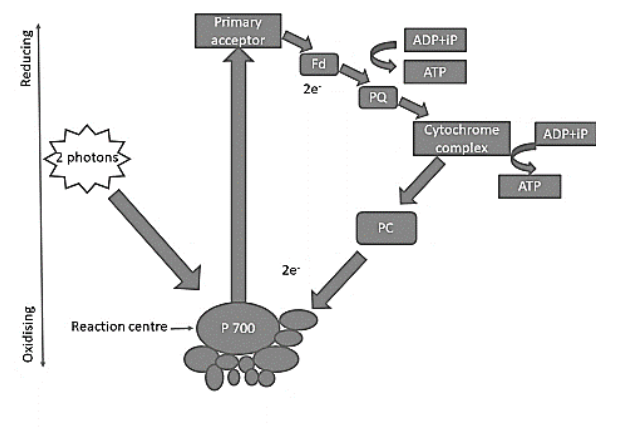
Define photophosphorylation and describe cyclic phosphorylation.
Answer
475.5k+ views
1 likes
Hint: In the word, photophosphorylation - Photo means light and phosphorylation is the addition of a phosphoryl group to a molecule. Cyclic phosphorylation is termed due to the movement of electrons in a cyclic manner.
Complete answer:
As understood from the etymology, photophosphorylation is a process in which plants convert adenosine diphosphate (
Cyclic photophosphorylation, occurring on the stroma lamellae or fret channels, is initiated by the high-energy electron produced by chlorophyll A in

Note: Cyclic and non-cyclic photophosphorylation are entirely different. In cyclic photophosphorylation, only PS
Similarly, cyclic photophosphorylation also occurs in photosynthetic bacteria to meet their energy needs. Bacteria have only one photosystem
Complete answer:
As understood from the etymology, photophosphorylation is a process in which plants convert adenosine diphosphate (
Cyclic photophosphorylation, occurring on the stroma lamellae or fret channels, is initiated by the high-energy electron produced by chlorophyll A in

Note: Cyclic and non-cyclic photophosphorylation are entirely different. In cyclic photophosphorylation, only PS
Similarly, cyclic photophosphorylation also occurs in photosynthetic bacteria to meet their energy needs. Bacteria have only one photosystem
Recently Updated Pages
Master Class 11 Economics: Engaging Questions & Answers for Success

Master Class 11 Business Studies: Engaging Questions & Answers for Success

Master Class 11 Accountancy: Engaging Questions & Answers for Success

Master Class 11 English: Engaging Questions & Answers for Success

Master Class 11 Computer Science: Engaging Questions & Answers for Success

Master Class 11 Maths: Engaging Questions & Answers for Success

Trending doubts
State and prove Bernoullis theorem class 11 physics CBSE

1 ton equals to A 100 kg B 1000 kg C 10 kg D 10000 class 11 physics CBSE

State the laws of reflection of light

One Metric ton is equal to kg A 10000 B 1000 C 100 class 11 physics CBSE

1 Quintal is equal to a 110 kg b 10 kg c 100kg d 1000 class 11 physics CBSE

Difference Between Prokaryotic Cells and Eukaryotic Cells




